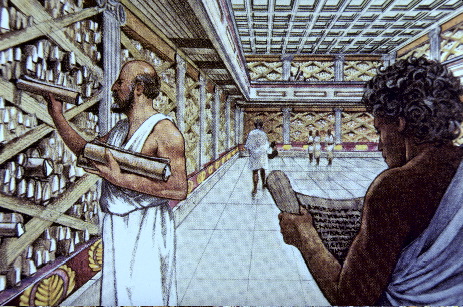Tuesday, May 14, 2013
The Great Library of Alexandria
Though public libraries first appeared in the fourth century BC, private libraries were quite common in
those times as well. Aristotle, for instance, had a large private collection. The ancient geographer Strabo
wrote: ‘Aristotle was the first to put together a collection of books and to teach the Egyptian kings how
to arrange a library’. That library, of course, was the Great Library of Alexandria. The Great Library of
Alexandria no longer exists, but it is not known for sure when the library was destroyed or who
destroyed it.
Julius Caesar is traditionally accused of demolishing the library in Alexandria. It is true that Julius
Caesar invaded Alexandria in 48-47 BC and his army set the fleet of ships in Alexandria harbour on fire.
Some historians believe that this fire in the harbour spread into the city of Alexandria and burned the
library down. However, there is hardly any evidence to prove this fact. The conclusion which seems to
be most accepted today is that the library in Alexandria existed, at least in part, four centuries after the
death of Julius Caesar. At that time, at the end of the fourth century AD, there was a general movement
to destroy temples and libraries and it seems more likely that the Alexandria library was destroyed at that
time.
The library of Alexandria is believed to have been a magnificent building housing the greatest collection
of scientific works of the time. It was founded by Ptolemy I, the General whom Alexander the Great
appointed as the ruler of the city named after him. It was Ptolemy’s son, Ptolemy II Philadelphus, who
decided to expand the library and succeeded in making it famous for its unique collection of
manuscripts. Under Ptolemy II and those who followed, the library continued to expand. Ptolemy II
wanted to create a library containing every Greek work ever written, as well as all the works from other
parts of the Western world that could be gathered together. The number of manuscripts in the library is
thought to have been between 300 000 and 700 000.
As each manuscript had to be copied by hand, a huge number of people were employed in preparing
manuscripts for the library. Manuscripts were bought, borrowed or taken from all over the Western
world to be copied and placed in the library. However, it was quite common to copy an original
manuscript, to return the copy to the owner and to keep the original for the library. Manuscripts were
often received from foreign powers in return for traded goods. Forcing citizens to pay their debts to the
government by giving manuscripts was also very common. It was in these ways that so many
manuscripts were collected in the library of Alexandria.
Subscribe to:
Post Comments
(
Atom
)


No comments :
Post a Comment